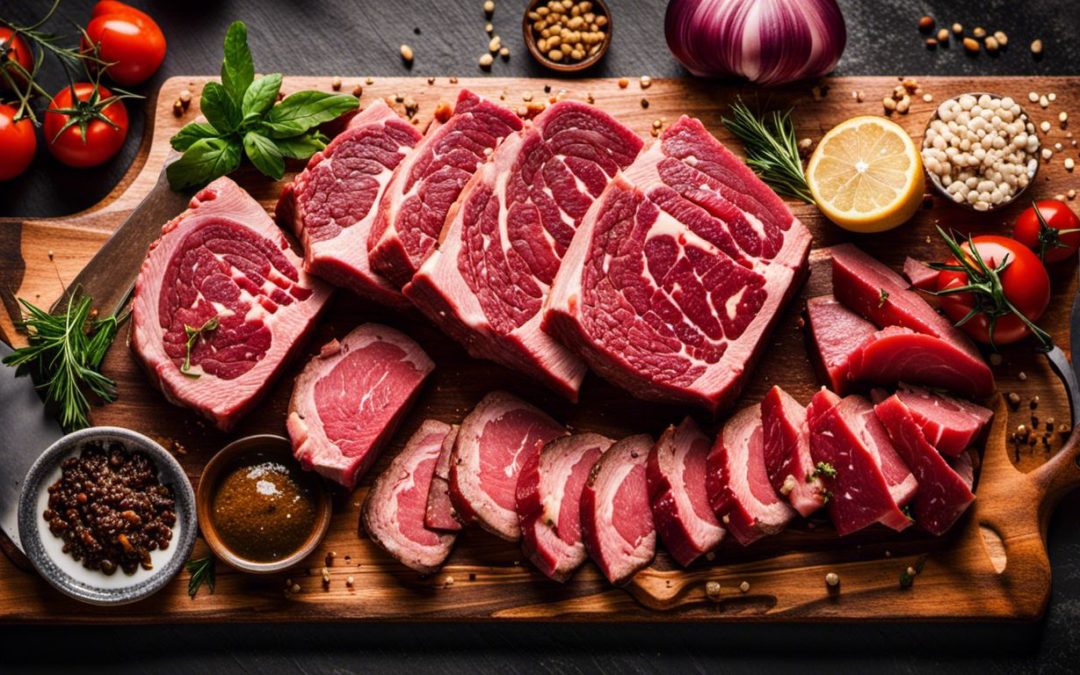Ever felt overwhelmed at the butcher’s counter, unsure of what grade of meat to choose for your steak night? We’ve been there too and found out that there’s a whole world behind those labels.
Did you know that the USDA recognizes eight different grades of beef? In this blog post, we aim to demystify these confusing grades, helping you make more informed decisions at the grocery store or butcher shop.
Let’s jump in and meat it head on!
Key Takeaways
- The USDA recognizes eight different grades of beef: Prime, Choice, Select, Standard, Commercial, Utility, Cutter, and Canner.
- Meat quality grades are determined by factors such as marbling (intramuscular fat) and maturity level of the animal.
- Yield grades determine the amount of usable meat obtained from a carcass and range from 1 (highest yield) to 5 (lowest yield).
- The grading system has its limitations and can be complex for consumers to understand.
USDA Grading System for Meat
The USDA grading system for meat is an essential tool in determining the quality and value of different cuts of beef.
Explanation of the grading system
The USDA uses a grading system to classify meat quality and yield. This system includes eight different grades: Prime, Choice, Select, Standard, Commercial, Utility, Cutter, and Canner.
These grades are determined by various factors such as marbling and maturity level of the animal. Marbling refers to the amount of intramuscular fat dispersed in the meat which gives it that juicy flavor when cooked.
Maturity is about how old an animal was at the time of slaughter which affects tenderness. While we usually only see prime, choice and select meats with appealing marbling levels in supermarkets or restaurants; other grades like standard or commercial mainly go to canners and large scale processors for further processing into ready meals or canned goods.
Eight different grades of meat: Prime, Choice, Select, Standard, Commercial, Utility, Cutter, and Canner
Understanding Meat Quality Grades
Meat quality grades are determined by factors such as marbling and maturity, which help to determine the tenderness and overall quality of the meat.
Factors considered in grading: marbling, maturity
The factors taken into account when grading meat are marbling and maturity. Marbling refers to the distribution of fat within the muscle, which adds flavor and tenderness. The more marbled the meat, the higher its grade.
Maturity refers to the age at which livestock is harvested, as older animals tend to have less tender meat. By considering these two factors, experts can determine the quality of meat and assign it an appropriate grade.
This ensures that consumers can make informed choices and enjoy delicious, well-aged cuts of beef.
Description of each grade and its characteristics
Let’s break down each grade of meat and its characteristics. We have eight grades: Prime, Choice, Select, Standard, Commercial, Utility, Cutter, and Canner. The grades available for consumers are Prime (the highest quality with abundant marbling), Choice (high-quality with less marbling than Prime), and Select (leaner but still tender).
The other grades are mainly used by canners and meat processors. Remember that the grading is based on the degree of marbling (intramuscular fat) and maturity. So next time you’re at the butcher shop or ordering a steak at a restaurant, keep these grades in mind.
Meat Yield Grades
Meat Yield Grades determine the amount of usable meat and are essential in evaluating the overall quality of different cuts.
Definition of yield grades
Yield grades are an important part of the meat grading process. They help determine the amount of usable meat that comes from a carcass. Yield grades take into account factors like fat thickness, ribeye area, and weight to estimate how much high-quality meat can be obtained.
These grades range from 1 (the highest yield) to 5 (the lowest yield). So, when you see a yield grade mentioned for a piece of meat, it tells you how efficient it is in providing delicious cuts for your meals.
Importance of yield grades in determining the amount of usable meat
Yield grades play a crucial role in determining the amount of usable meat from a carcass. These grades evaluate how much lean, boneless meat can be obtained from different cuts of beef.
By considering factors such as fat thickness and muscle development, yield grades help meat processors determine the most efficient way to utilize each carcass. This ensures that consumers get the best value for their money by maximizing the amount of high-quality, lean meat they receive.
So next time you’re enjoying a delicious steak or roast, remember that yield grades have played an important part in bringing that juicy piece of meat to your plate.
Problems with the USDA Grading System
The USDA grading system for meat has faced criticism and limitations due to a lack of transparency and consumer confusion.
Criticisms and limitations of the grading system
We acknowledge that the USDA grading system for meat is not without its criticisms and limitations. One major concern is the lack of transparency and potential confusion for consumers.
The grading system can be complex and difficult to understand, which may make it challenging for people to know what they are actually purchasing. Additionally, some argue that the grading system focuses too heavily on marbling as an indicator of quality, disregarding other important factors such as tenderness or flavor.
While the grading system has its flaws, it does provide a general guideline for assessing meat quality. It’s important for consumers to educate themselves about the grades and consider their own preferences when making purchasing decisions.
Lack of transparency and consumer confusion
Consumers often face a lack of transparency and confusion when it comes to understanding meat grades. The USDA grading system can be complex and difficult to navigate, leaving many unsure of what they’re actually getting when they purchase meat.
This lack of clarity can lead to frustration and disappointment for consumers who want to make informed choices about the quality of their meat. However, by educating ourselves about the different grades and asking questions at the butcher counter, we can begin to demystify this process and ensure that we’re getting the best possible product for our money.
Conclusion
In conclusion, understanding the different grades of meat is important for any meat lover. The USDA grading system provides a standardized way to assess the quality and yield of beef.
In the beef industry, meat quality grades play a crucial role in determining the overall quality and tenderness of beef. The beef grading system, overseen by the United States Department of Agriculture (USDA), categorizes beef into different grades based on various factors.
At the top of the grading system is USDA Prime beef, which represents the highest quality beef available. Prime beef is well-marbled with fat, making it exceptionally tender and flavorful. It is often served at high-end restaurants and steakhouses.
Below Prime, there are two other main quality grades: USDA Choice and USDA Select. Choice graded beef is also well-marbled and of high quality, while Select beef is leaner and may have less marbling.
Apart from these three primary grades, there are five additional grades, including Standard and Commercial grades, which are less commonly seen in the market. Additionally, Canner grades are used for beef that is processed into ground beef and other processed products.
The USDA grading system evaluates beef based on two primary factors: quality grade and yield grade. The quality grade is primarily based on the amount of marbling present in the meat, which contributes to its tenderness and flavor.
The yield grade, on the other hand, assesses the amount of usable lean meat on the carcass. It determines the proportion of meat that can be used for various cuts, as well as the amount of fat within the beef.
Understanding the different USDA grades helps consumers make informed choices when buying beef. While Prime beef is the best quality, Choice and Select beef also offer high-quality options, and their leaner attributes may appeal to some individuals.
Another well-known type of beef is Wagyu beef, which comes from Japanese cattle breeds known for their high marbling and exceptional flavor. Wagyu beef is prized for its tenderness and is often considered a delicacy.
Angus beef is also widely popular and known for its superior taste and tenderness. It comes from Angus cattle, a breed recognized for producing high-quality beef.
Whether you’re looking for a juicy Prime steak or a leaner Select cut, knowing the differences in meat grades can help you make an informed choice when it comes to your next meal. So go ahead, explore the world of meat grades and discover your new favorite cut!
FAQs
Q: What are the different grades of meat?
A: The different grades of meat refer to the different quality levels assigned to beef by the USDA. The grades are based on two main factors: beef quality and yield grade.
Q: What is beef grade?
A: Beef grade refers to the quality level assigned to beef based on the marbling, tenderness, and juiciness of the meat.
Q: How is beef graded?
A: Beef is graded based on the evaluation of the carcass by a USDA grader. The grader assesses the marbling, maturity, and texture of the meat to determine its grade.
Q: What are the USDA beef grades?
A: The USDA beef grades include prime, choice, select, and a few others.
Q: What is prime beef?
A: Prime beef is the highest grade of beef and it has the highest level of marbling, making it very tender, juicy, and flavorful.
Q: What is choice beef?
A: Choice beef is the second-highest grade of beef and it also has a good amount of marbling, resulting in tender and flavorful meat.
Q: What is select beef?
A: Select beef is the third-highest grade of beef and it has less marbling compared to prime and choice, but it is still of good quality and can be tender when cooked properly.
Q: How many grades of beef are there?
A: There are eight grades of beef in total, ranging from prime to canner grade.
Q: What are the criteria for grading beef?
A: The criteria for grading beef include factors like marbling, maturity, texture, and color of the meat.
Q: How do the components make up the meat affect the grade?
A: The components that make up the meat, such as the amount of marbling and texture, play a significant role in determining the overall grade of the beef.
Greetings!
With over two decades of diverse experience in the meat industry, I proudly stand as an expert in all things meat. My journey commenced with a strong foundation in hospitality, where I honed my culinary skills as a chef in prestigious restaurants and on luxurious superyachts worldwide.
However, my true passion lies in the art of butchery. Throughout my extensive career, I have had the privilege of working with renowned meat purveyors and mastering the craft of meat cutting and preparation. From breaking down whole carcasses to meticulously selecting prime cuts, my butchery expertise is at the core of my meat knowledge.
Having immersed myself in various cultures and cuisines, I have honed my skills to deliver exceptional dining experiences, crafting delectable dishes that celebrate the natural flavors of different meats. Whether it's sourcing the finest meats for discerning clients or sharing valuable tips on meat selection and cooking, I take pride in elevating the meat experience for both professionals and enthusiasts.
My journey has taken me from the bustling kitchens of top-rated restaurants to the heart of meat processing facilities, gaining insights and honing my skills to become a true meat connoisseur. Now, I am enthusiastic about sharing my expertise, offering valuable insights on meat selection, cooking techniques, and the art of butchery.
















